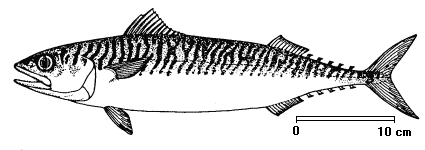
Scomber scombrus Linnaeus, 1758

Synonyms: Scomber scomber Bonnatere, 1788; Scomber punctatus Canah, 1857; Scomber scombrus Smith, 1893; Scomber scombrus Banarascu, 1964
Common names: Engl: Atlantic mackerel; Bulg: Skumrija; Georg: Scumbria, Makreli; Rom: Scrumbie albastra; Russ: Skumbriya; Turk: Uskumaru baligi; Ukr: Skumbriya
Order: PERCIFORMES
Family: SCOMBRIDAE
Taxonomic descriptions: S. scombrus is characterized by an elongate and rounded body, a pointed snout, a slim caudal peduncle, 2 dorsal fins; behind the second dorsal and the anal fins a number of 5 finlets; the 2 dorsal fins are widely separated (interspace at least equal to the length of the first dorsal fin base); an adipose lid covers the front and hind edges of the eye; head and body are entirely covered with small scales; 11 to 13 spines in the first dorsal fin; 2 small keels on each side of the caudal peduncle (at the base of the caudal fin lobes), but no central keel between them; colour of the back brilliant greeny-blue, often turning to bluish-black on the head; sides metallic, belly white, a series of very characteristic dark, curving lines across the back. Size: maximum: 50 cm; common: 30-35 cm.
 IUCN
Status:
IUCN
Status:
World level:
Black Sea Regional level:
Subregion level: EN
Distribution:
Habitat type, Critical habitats, Limiting factors: A schooling pelagic fish inhabiting cold and temperate waters. Common in most areas of the western and central Mediterranean Sea; occasionally also entering the Azov Sea; rare in the eastern Mediterranean; not found on the coasts of Israel; present also in the North Atlantic, from Murmansk to the Canary Islands and from Cape Lookout to Labrador. Pollution of Bosphorus zone and the presence in greater quantities of predators such as tunas, dolphins and sharks feeding on mackerels.
Biology: The species spends the winter in the Marmara Sea, in front of the Bosphorus; entering the Black Sea during the spring they move northward, reaching the Romanian coasts in April-May, when the temperature of sea water is 8°C. In October-November they move southward and at latest in December quit the Black Sea. The spawning takes place late in winter - early in spring in the Marmara and Aegean Sea. The individuals staying in the Black Sea in winter do not reproduce, because the juveniles need to move down to greater depths, where there are no hostile. Feeds chiefly on pelagic invertebrates (Acartia, amphipods, mysids), pilchards, sprat and eels.
Population trends: The stocks of the species considerable diminished due to unfavorable conditions both for feeding and breeding. In the Romanian Black Sea waters, during the 1960s there were separate statistics for this species (thousand tons/year), after that it disappeared as a commercial species; in the last two decades, it did not fall into catches. On the Turkish coasts, the catches recorded by FAO were of 39 t (1989), 56 t (1990), 780 t (1991).
Threats: Overfishing, pollution, predators (bonito, sharks and dolphins).
Conservation measures taken: In the last 25 years, special gill nets were not used for mackerel.
Conservation measures proposed: Ensure of the migration into the Black Sea through the fishways by mitigation of eutrophication/pollution.
References:
Compiled by: G.Radu, F.Verioti